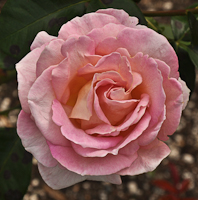 Like most other woody ornamental plants
of the landscape,
roses need occasional pruning to keep them in shape.
Generally, research shows that it is better to prune
hybrid teas,
floribundas,
polyanthas and
grandifloras in early spring rather than in
the fall or winter. Tissue near pruning cuts made in the fall may lose
their winter hardiness and cause even more winter dieback.
Like most other woody ornamental plants
of the landscape,
roses need occasional pruning to keep them in shape.
Generally, research shows that it is better to prune
hybrid teas,
floribundas,
polyanthas and
grandifloras in early spring rather than in
the fall or winter. Tissue near pruning cuts made in the fall may lose
their winter hardiness and cause even more winter dieback.
As with any woody plant, it is always a
good idea to cut out any dead, diseased or dying plant tissue. This is
especially pertinent in the spring when there may be dead parts of the
cane due to winter injury. In the spring, there are often 3 different
colored parts to the cane. On top will be black tissue which is
definitely dead. On the bottom, the cane is nice and green showing that
it is alive. In between is a brownish colored tissue that makes the
transition between green and black. It is usually a good idea to
cut down from the top until you reach tissue that is moist after the
cut. That indicates live tissue.
Many types of roses, especially the
hybrid teas, consist of a fancy flowering rose (the scion)
grafted to a
sturdy, wild type rose rootstock. So, never prune these types below the
swollen graft union. To do this or if winter kills the cane to the graft
union, the value of the plant is gone. It will send up shoots from the
rootstock which will have a much different type of bloom or none at all.
When pruning to reduce the length of a
cane, always cut just above an outside facing bud. This will encourage a
nicer form and a bushy effect. Cutting to an inside bud will lead to
canes going toward the inside of the plant and give an unpleasing
effect.
Of course, always use sharp tools. Dull
tools tend to rip tissue rather than cutting it leaving jagged edges
that are unsightly and take longer to callus over.



